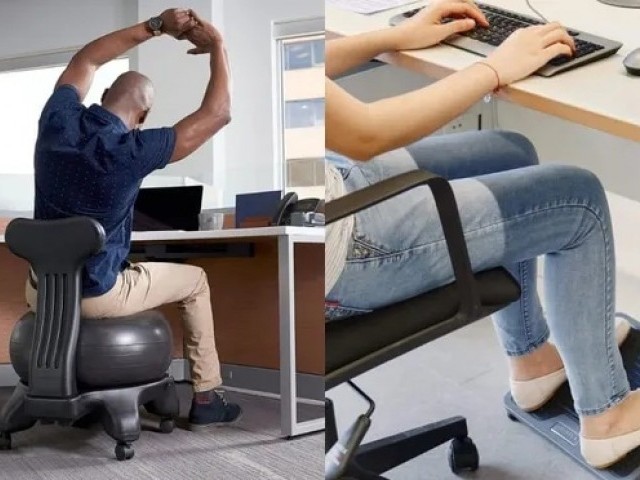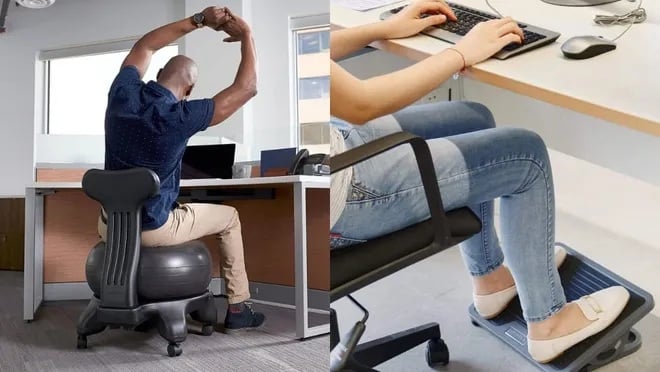
Improper sitting posture leads to many physical complications and these problems prove to be very painful later on. Photo: File
There are some minor habits, which if corrected, a person can avoid many medical and physical problems. One of them is our sitting habits, which is very important to understand for our health.
Improper sitting posture leads to many physical complications and these problems prove to be very painful later on. British physiotherapist Nick Sinfield has identified some common sitting and standing posture mistakes, which can help you correct them.
Don’t slouch
Sitting slouched is often comfortable. But over time this position can stress the muscles and cause pain. Get into the habit of sitting properly. You may not feel comfortable at first because your muscles are not ready to move into the right position, but you will gradually get used to it.
Do not arch your shoulders
While working on your computer at your desk, your head may lean forward which can lead to rounded upper back and resulting stiff shoulders. The same thing happens when you use your phone, which can cause problems like ‘text neck syndrome’, which can cause neck pain and stiffness, back pain and headaches.
In addition to focusing on correcting your posture, physio Nik Senfeld recommends exercises or specific types of exercise to correct and strengthen the upper back, neck, and back of the shoulders, chest cavity, and neck posture. .
Don’t stick your chin out
Just as your head may tilt forward while sitting at work, your neck may also tilt in the opposite direction. Follow these guidelines to avoid this:
* Gently lengthen your neck as you tuck your chin in.
Pull the shoulder blades down and toward the spine.
Keep the lower abdominal muscles tight to maintain a natural bulge in the lower back.
* Adjust your chair so that it is not too low and your screen is not too high.
The following exercises are useful for neck stiffness and pain.
Gently lower your left ear towards your left shoulder to reduce neck strain. Hold it for ten to 15 deep breaths, then repeat the exercise on the opposite side.
* For a neck rotation exercise, slowly roll your chin towards one shoulder. Hold it on one side for ten to 15 deep breaths, then repeat the exercise on the opposite side.
Do not stand on one leg
When we have to stand for a long time there is something we do to get some rest. But to keep ourselves upright, we usually put excessive pressure on our lower back and one side of our hip instead of using our glutes and vital nerves. Over time, muscle imbalances around the pelvic area (pelvic area) can develop. Always get into the habit of standing with your weight evenly distributed on both legs.
Keep the hips parallel to the body
Wearing high-heeled shoes and carrying excess weight around the abdomen can result in your body having the popular ‘Donald Duck’ posture. To correct this, imagine that a rope is tied to your head and is being pulled upwards. The idea is to keep your body perfectly straight, with the natural curve of your spine, your neck straight, and your shoulders parallel to your hips.
Stay strong
Without a natural bulge in the lower back, when your pelvis tilts forward and your back is flat, your body leans forward. This bulge is often caused by muscle imbalances, but sitting for long periods of time can also contribute to a flat back.
To improve this, Sunfield recommends exercises to strengthen the core, glutes, back of the neck and shoulders, and back muscles. Keep your shoulders back and relaxed to stand properly. Tuck your stomach in and keep your feet hip-width apart. Balance your weight evenly on both feet, don’t let your head tilt forward, back or to one side and keep your legs straight, but relax your knees. (Thanks to BBC Urdu)
(function(d, s, id){
var js, fjs = d.getElementsByTagName(s)[0];
if (d.getElementById(id)) {return;}
js = d.createElement(s); js.id = id;
js.src = “//connect.facebook.net/en_US/sdk.js#xfbml=1&version=v2.3&appId=770767426360150”;
fjs.parentNode.insertBefore(js, fjs);
}(document, ‘script’, ‘facebook-jssdk’));
(function(d, s, id) {
var js, fjs = d.getElementsByTagName(s)[0];
if (d.getElementById(id)) return;
js = d.createElement(s); js.id = id;
js.src = “//connect.facebook.net/en_GB/sdk.js#xfbml=1&version=v2.7”;
fjs.parentNode.insertBefore(js, fjs);
}(document, ‘script’, ‘facebook-jssdk’));



